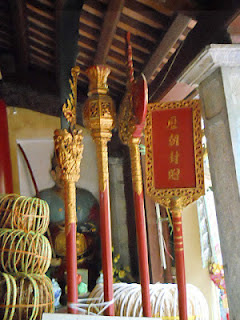 Hanoi's Old Quarters has a history spanning over 2,000 years and represents the eternal soul of the city.
Hanoi's Old Quarters has a history spanning over 2,000 years and represents the eternal soul of the city.Huge mangrove tree trunk that still existed along this Thanh Ha Street potruding in front of some of the shophouses reminds one that Hanoi was once a swampy area.
Mangrove roots not only provide support in unstable soils and to withstand currents and storms, but also breathe air.

To avoid suffocation in the oxygen poor mud, mangrove trees snorkel for air.
They develop aerial or air-breathing roots. These take in aboveground air.
All aerial tree roots have on their surface, special tiny pores to take in air .
Only air can get through the lenticels, not water or salts. All aerial roots also contain large air spaces.
These not only transport air, but also provide a reservoir of air during high tide when all the aerial roots may be underwater.
The function of aerial roots are to absorb air and to provide structural support in the soft mud. Roots for absorbing nutrients are tiny and emerge near the muddy surface.
Bamboo and rattan products were along Thanh Ha Street.
This old mangrove tree was contained to prevent it from further extending onto the building.
Very old Confucian temple nestled in between the old shoplots.
Confucius was a Chinese philosopher born in Qufu,a city in southwestern Shandong province, People's Republic of China.
The philosophy of Confucius emphasized personal and governmental morality, correctness of social relationships, justice, and sincerity.
He also championed strong family loyalty, ancestor worship, and respect of elders by their children.
View of the temple's altar.

A list of temple's programmes from January till December.

Statue of a deity,a kind of Chinese hero worship.

Multi-layered lantern.

The emperor's mace.
Ancient Chinese battefield armoury. These weapons were used horse-to -horse fighting.

Noticed that each of them has a hook beneath it which is used to disable the weapon of the opponent.
Hence protecting himself, protecting his horse, attacking his enemy, and attacking his enemy’s horse is of upmost importance.
He will remain on equal footing with his adversary only while he is mounted.
If the horse becomes disabled or the enemy knocks him off the horse, he is lost.
Of course, attacking the enemy is uppermost in his mind.
A long weapon such these fulfilled all these requirements.
A pair of Chinese traditional parasols designed for a ceremonial purpose.
These are altars of God of Longevity.
Offering Bia Hoi to Chinese god.
Bia Hoi is the popular draft beer of Vietnam.
Garden sculptures.
A pair of carp fish sculpture beside the table altar representing properity.

The National Flag of the Socialist Republic of Vietnam.
This must be the Vietnamese name of the temple. Di Tich, Dinh thanh Ha.da Xep Hang,Cam Vi Pham.
While in Hanoi,tourists must also visit the first university of Vietnam.
Văn Miếu or Temple of Literature, known as "pagode des Corbeaux" during the period of French colonisation, was founded as a Confucian temple in 1070.
The Temple of Literature is open Tuesday to Sunday from 8:30 to 11:30 and 13:30 to 16:30.
Admission is 12,000 Dong with a small guide brochure costing an additional 3,000 Dong.
Take bus No:02,18,23,32,34,38 or 45 and stop near Embassy of Thailand along Nguyen Thai Hoc Road and it's just nearby.









No comments:
Post a Comment